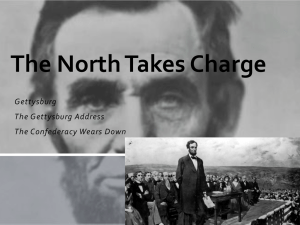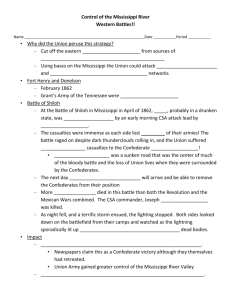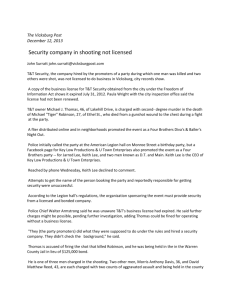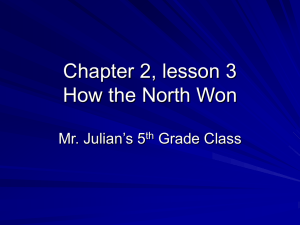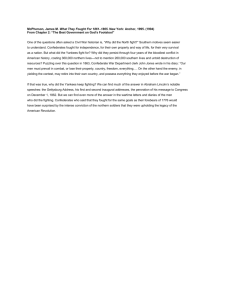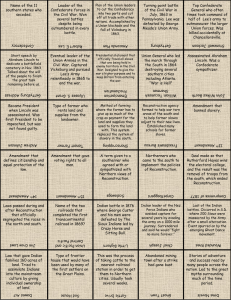File
advertisement
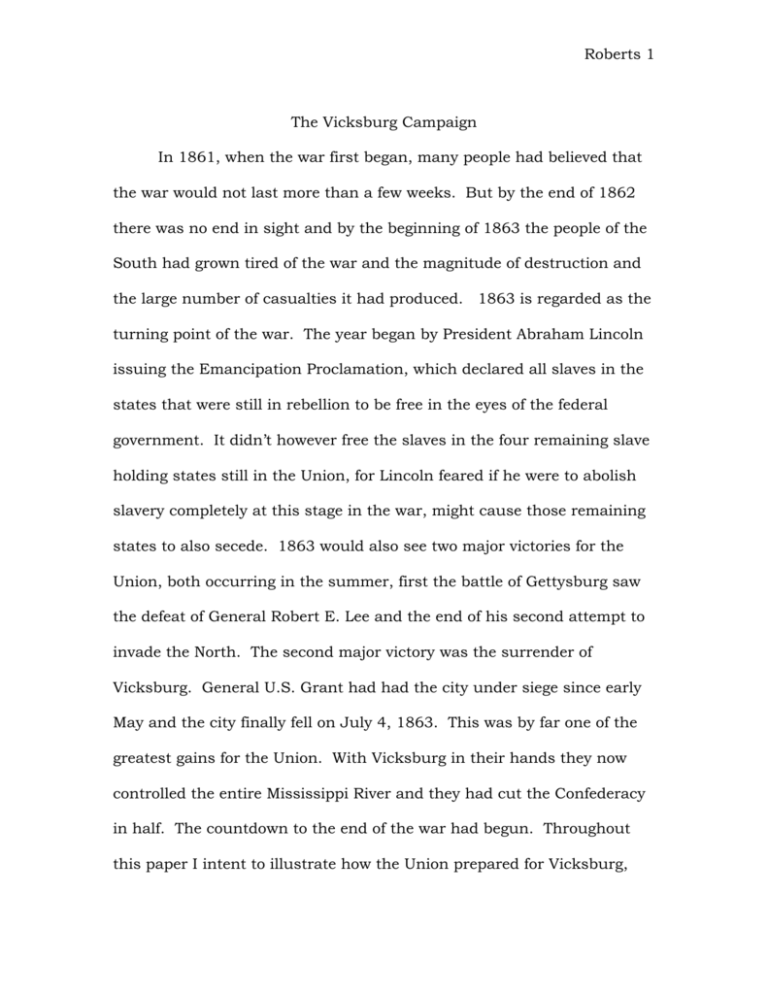
Roberts 1 The Vicksburg Campaign In 1861, when the war first began, many people had believed that the war would not last more than a few weeks. But by the end of 1862 there was no end in sight and by the beginning of 1863 the people of the South had grown tired of the war and the magnitude of destruction and the large number of casualties it had produced. 1863 is regarded as the turning point of the war. The year began by President Abraham Lincoln issuing the Emancipation Proclamation, which declared all slaves in the states that were still in rebellion to be free in the eyes of the federal government. It didn’t however free the slaves in the four remaining slave holding states still in the Union, for Lincoln feared if he were to abolish slavery completely at this stage in the war, might cause those remaining states to also secede. 1863 would also see two major victories for the Union, both occurring in the summer, first the battle of Gettysburg saw the defeat of General Robert E. Lee and the end of his second attempt to invade the North. The second major victory was the surrender of Vicksburg. General U.S. Grant had had the city under siege since early May and the city finally fell on July 4, 1863. This was by far one of the greatest gains for the Union. With Vicksburg in their hands they now controlled the entire Mississippi River and they had cut the Confederacy in half. The countdown to the end of the war had begun. Throughout this paper I intent to illustrate how the Union prepared for Vicksburg, Roberts 2 how the city was eventually taken and what effect the fall of Vicksburg had on the Confederacy as well as the Union armies. The Union army began the year of 1862 with a series of victories in the Upper South. In February Fort Henry, which is located on the Tennessee River, fell to Union Forces, then ten days later the Confederates lost Fort Donelson. Then finally the Union forces won control of Pea Ridge, Arkansas. The Confederates’ defense line in Kentucky also fell for good when Albert Sydney Johnston withdrew from his position there and fell back through Tennessee. Now Kentucky and much of Tennessee in Union hands the Confederates were on the run trying to create a new line of defense in order to keep some of their most important strategic points out of Union hands. The most sought after position for the Union was without question the city of Vicksburg. And with their advance down the Mississippi River they were setting up their approach, but first there were several other key positions that needed to be secured before they could embark on the task of taking the city and with it, the entire control of the Mississippi River. After they lost they control in Kentucky, the Confederates set out to put as many troops as possible in the town of Corinth, Mississippi. Two major railroad lines crossed here, which made it a key target for Union forces. If the Union forces could take the railroad then they could sever the backbone of the Confederacy. Now with the with Union forces, led by General Grant, Roberts 3 stationed only 20 miles away at Pittsburg Landing, the Confederates had to move quickly is they were going to defend one of their few remaining strongholds in the west. Grant’s plan was to take Corinth then move south through the heart of Mississippi and eventually take Vicksburg. Jefferson Davis had sent word to General Johnston that if he didn’t stop Grant before his forces were united with General Buell then the chances of holding Corinth would be drastically effected. So Johnston set out to meet up with the Union army at Shiloh. The Confederates saw success the first day of fighting as they drove Grant’s forces back to the river but had not completely defeated his army. The Confederates had also lost Johnston as he had been killed during the battle. During the night Buell’s army joined Grant and when the Confederates awoke in the morning they found themselves with a new leader and up against a revived opponent. The Confederates would eventually retreat to Corinth and Grant’s plans would be put on hold for at least a month. By the end of May the Union forces controlled the town of Corinth, but they did not have to take it by force. Under the command of Beauregard, the Confederates had evacuated and abandoned the city to avoid a major altercation with the Union army. Now with Corinth in their hands, along with New Orleans, Baton Rouge, and Natchez, then Union armies set their sights on Vicksburg the last major stronghold the Confederates held in the west.1 Roberts 4 Vicksburg, known as “the Confederate Gibraltar,” was very important to the Confederates because the city occupied the first high ground located on the river below the city of Memphis. There was also a railroad that began at Vicksburg that ran east and connected with roads and other major points throughout the CSA. Another railroad, running west, began there and running all the way to Shreveport, Louisiana. Vicksburg was the last remaining port on that was still in Confederate control that connected the western states, which were divided by the Mississippi River, to those in the east. These are the reasons that made it so important for the Union to take control over the city.2 To occupy this area was essential for the Union if they were to take over complete control of the Mississippi River and succeed in splitting the Confederacy in half. From the very beginning Abraham Lincoln was quoted as saying, “Vicksburg is the key. The war can never be brought to a close until the key is in our pocket.”3 Lincoln knew that if the Union Army was unable to secure the city then the Confederates could prolong the war as long as they controlled the city. This is the very reason Lincoln wanted Grant to stop at nothing to put the city securely in Union hands. After the occupation of Corinth the Union forces had move the headquarters to Oxford, then to Holly Springs, now with Grant’s offensive failing, he was on the move to Memphis. During this period Grant had had his lines of communication disrupted on the behalf of Van Dorn and Nathan Bedford Roberts 5 Forrest, who had destroyed his large supply depot at Holly springs. With word that Sherman had been defeated on his approach to Vicksburg and with Halleck’s direction to go at once with all available forces to help Sherman; Grant abandoned his overland advance and headed for Memphis to back up Sherman. After Sherman was unable to break through the Confederate lines at Chickasaw Bayou, he decided to withdraw and instead begin with a combined naval and land movement against Fort Hindman which was on the Arkansas River at Arkansas Post some 50 miles up the Arkansas River from where in met with the Mississippi. Sherman began his expedition without informing Grant. On the evening of January 9 Union boats began landing troops near Arkansas Post. They started up river and overran Confederate trenches and which caused them to retreat to the protection of the fort. Now with the Confederates on the run the Union forces began bombarding the Fort on January 10. By the afternoon of January 11 the Confederates had surrendered. Even though there were a high number of Union casualties and it didn’t contribute to the capture of Vicksburg, it did eliminate one more obstacle to Union shipping on the Mississippi. Grant was not happy to learn the McClernand had conducted the operation without approval but since it was a successful operation, he did not take punitive action against him or Sherman. Now Grant prepared to withdraw all his forces from North Mississippi and concentrate them at Young’s Point Roberts 6 which lay opposite of Vicksburg on the Mississippi River.4 He now began a series of attempts at building a canal, the first at Young’s point, the second at Lake Province and the third at Yazoo pass.5 The 1862 attempt at a canal had been abandoned because of an insufficient amount of troops. But it had the potential to offer a route downriver that would bypass Vicksburg’s guns. In late January Sherman’s men resumed the digging of the canal. They were urged by Grant who had been advised that President Lincoln like the idea and believed that it would work well.6 The canal was not however, properly engineered for the hydrology of the Mississippi River. A sudden rise in the river broke through the dam at the head of the canal and flooded the area. In a desperate effort to rescue the project the Union forces brought in dredges, but they were exposed to confederate artillery fire from the bluffs at Vicksburg and forced to retreat. By late March, work on the canal was abandoned.7 Grant then ordered General McPherson to construct a canal of several hundred yards from the Mississippi to Lake Providence, northwest of the city. This would allow passage to the Red River, through Bayous Baxter and Macon, and the Tensas and Black Rivers. Reaching the Red River, Grant's forces could join with Banks at Port Hudson and bypass the Vicksburg defenses. This was the only successful bayou expedition to bypass Vicksburg defenses.8 The next attempt was to get to the high ground of the bluffs above Haines Bluff and below Yazoo City by blowing Roberts 7 up the levee near Moon Lake, which was located about 150 miles north of Vicksburg, then following the Yazoo Pass into the Coldwater River and then on to the Tallahatchie River and finally into the Yazoo River at Greenwood, Mississippi. The dikes were exploded on February 2, beginning the Yazoo Pass Expedition. Union boats began moving through the pass on February 7, but low-hanging trees over the pass destroyed anything on the gunboats that was above the deck and to add to it the Confederates felled more trees that blocked the way. The delays allowed the Confederates time to build Fort Pemberton near the Greenwood which held off the naval force on three separate occasions. The Union attempt to use the Yazoo Pass ended in early April as plans for another canal began.9 On March 16, Admiral Porter began an effort to go up the Yazoo Delta by way of Steele’s Bayou, which was just north of Vicksburg, to Deer Creek. This is known as the Steele’s Bayou Expedition. The plan was to outflank Fort Pemberton so that the Union army could land troops between Vicksburg and Yazoo City. However the Confederates once again felled trees into the path of the Union boats and they eventually became immobilized. The Confederates then moved into and threatened to capture the Union forces. Sherman sent in infantry to help resist the Confederates and Porter’s approach was abandoned as too difficult.10 The final attempt at a canal was from Duckport Landing to Walnut Bayou. It was aimed at getting lighter boats past Vicksburg. It Roberts 8 was eventually decided by Sherman and Grant to abandon the canal and plan something new.11 From December through March, including Chickasaw Bayou and the Mississippi Central advance, seven "experiments", by Grant had failed. Grant claimed, “All of these failures would have been very discouraging if I had expected much from the efforts; but I had not.”12 All of the Bayou Operations were failures, but Grant wasn’t going to quit just yet. His final options were to try and cross the river south of Vicksburg at Hard Times, Louisiana and attack from the south and east, or he could join with Banks and attempt to capture Port Hudson and then together try to take Vicksburg. Porter would have to sneak past the guns at Vicksburg to get enough gunboats south of the city but, once downstream of Vicksburg; they would not be able to return.13 On March 29, Grant sent McClernand and his troops out to begin building bridges and roads with the hopes that he might also capture Grand Gulf. By April 17, they had a road from Milliken’s Bend to the proposed river crossing below Vicksburg.14 On the night of April 16, a clear and moonless night, Porter sent seven ironclad gunboats and three empty troop transport boats, which were loaded with supplies, down the river. Their objective was to run past the bluff, so they took great care to minimize the noise and the lights. They were spotted by Confederate sentries and they opened with massive artillery fire from the bluffs. Roberts 9 There were fires set along the banks to help improve the visibility and the Union gunboats answered with artillery fire of their own. The Confederates only managed to hit the tops of the Union boats and they hug the east shore and went right under the Confederate cannons. The fleet managed to survive with little damage; however the Henry Clay was disabled and burned.15 The Union sent six more boats loaded with supplies on April 22, with one boat failing to make it.16 Now Grant needed to divert the attention of Pemberton away from the site of the river crossing. Grant sent Sherman on a feint against Snyder’s Bluff which was inconclusive.17 He also sent Colonel Benjamin Grierson on a raid through central Mississippi, known as Grierson’s Raid. Grierson was successful at drawing out Confederate forces to chase him which spread out Pemberton’s forces and made the fall of Vicksburg a step closer to reality.18 Now with the ironclads past Vicksburg, Porter began attacking the fortifications and batteries at Grand Gulf. The intentions of Porter were to silence the Confederate guns and secure the area with McClernand’s troops who were to accompany the transport barges. Grant marched his men to Coffee Point below Grand Gulf then embarked the troops across the Mississippi River to Bruinsburg, then marched towards Port Gibson, Mississippi. On May 1, on their way to Port Gibson, Grant’s army encountered Confederate forces on two different occasions, forcing them back each time and eventually securing a Roberts 10 beachhead on the Mississippi River. From here Grant was suppose to head south to Port Hudson and me up with Banks and together they would capture Vicksburg. But instead Grant decided to go ahead and advance towards Vicksburg. The Confederates evacuated Grand Gulf and headed towards Hankinson’s Ford which was across the Big Black and barely escaping a Union trap. Grant had intended to follow along the same path but, scouting parties had found that Pemberton had a defensive position setup to the south of Vicksburg so Grant instead decided to seize the railroad from Jackson and cut off the railroad supply lines to Vicksburg. On May 12, the Confederates attempted to ambush the Union forces at Raymond. The Confederates had success at first but eventually were forced to retire when additional Union troops arrived and counterattacked. The Confederates were ordered to withdraw to Jackson leaving the Southern Railroad of Mississippi exposed to the Union forces. This proved too severe the lifeline of Vicksburg. Two days later Sherman’s and McPherson’s troops were able to capture the Mississippi capital of Jackson when Johnston ordered the Confederates to evacuate the city. The Union forces celebrated by burning parts of the town and destroying several factories there. Two days after the fall of Jackson the Union forces engaged with the Confederates at the Battle of Champion Hill. Pemberton and the Confederates were determined to keep the Union forces from advancing to Vicksburg. By the time Grant had Roberts 11 arrived the Confederates began to retreat in disorder. The Union forces continued to advance and eventually sealed off the escape route with was the Jackson Road. With the Union on the advance the Confederates were on full retreat to Vicksburg. By night fall the Confederates had reached the Big Black River Bridge. Union advance continued and the Confederates began to withdraw across the two bridges and as soon as they had all crossed they burned the bridges to prevent the Union from pursing onward. The following day, on May 18, the Union army converged on Vicksburg and trapped Pemberton and his troops within the city. Grant attempted to break through to the city on May 19 and 22, but each was repulsed. Pemberton was ordered to evacuate the city and save his army, but he didn’t think he would be able to withdraw safely. Johnston had planned to attack Grant in hopes to relieve Pemberton, but it was not arranged in time and Grant besieged the Confederate Army inside the city of Vicksburg. For six weeks the Union army constantly bombed the city continually weakening the forces there. Johnston reached the Big Black River on July 1 attempting to attack Grant. He delayed a potential difficult encounter with Sherman until it was too late and then fell back to Jackson. On July 4, 1863, after six weeks of siege, the city of Vicksburg finally surrendered to Grant’s army and thus ending the campaign for Vicksburg which had been ongoing since December of 1862.19 Roberts 12 The Union Army now controlled the entire Mississippi River and had successfully cut the Confederacy into two parts. In Jefferson Davis’ book, The Rise and Fall of the Confederate Government, he said that, “The loss of Vicksburg and Port Hudson was the surrender of the Mississippi [River] to the enemy.”20 On the previous day Robert E. Lee had been defeated at the battle of Gettysburg combined with the fall of Vicksburg the war seemed to be drawing closer to an end. After Vicksburg Grant and Sherman continued across the South, on his way out of Mississippi Sherman burned a path from Jackson to Meridian which would be the precursor to what he would also do in Georgia. After successfully capturing Vicksburg Grant was promoted to Major General in the Union Army; he was then brought east to fight the armies in Virginia and eventually would defeat Robert E. Lee. Vicksburg turned out to be the key to the war as Lincoln had stated before. Although it took two years after Vicksburg fell before the Confederate Army would surrender it was the beginning of the end for the Confederate States of America. Roberts 13 Notes Ben Wynne, Mississippi’s Civil War, (Macon, Georgia: Mercer University Press, 2006), 58-70. 1 Ulysses S. Grant, Personal Memoirs of Ulysses S. Grant, (New York: Cosimo, 18851886), 165. 2 Paul Calore, Land Campaigns of the Civil War. Jefferson, (North Carolina: MacFarland & Company, Inc., 2000), 95. 3 John Fiske, The Mississippi Valley in the Civil War (Cambrige: Houghton, Mifflin & Co., 1902), 197-210. 4 William T. Sherman, Memoirs of General William T. Sherman, (St. Louis: Plain Label Books, 1875), 477. 5 6 Fiske, 207-209. 7 Fiske, 211. 8 Fiske, 212-213. 9Grant, 176-177. 10Fiske, 217-218. 11 Sherman, 492-495 12 Grant, 178. 13 Fiske, 224. 14 Grant, 181-182. 15 Sherman, 497-498. 16 Grant, 185. 17 Sherman, 498. 18 Grant, 191-192. 19 Grant, 188-224. Jefferson Davis, The Rise and Fall of the Confederate Government, (New York: Appleton and Company, 1881), 425. 20
